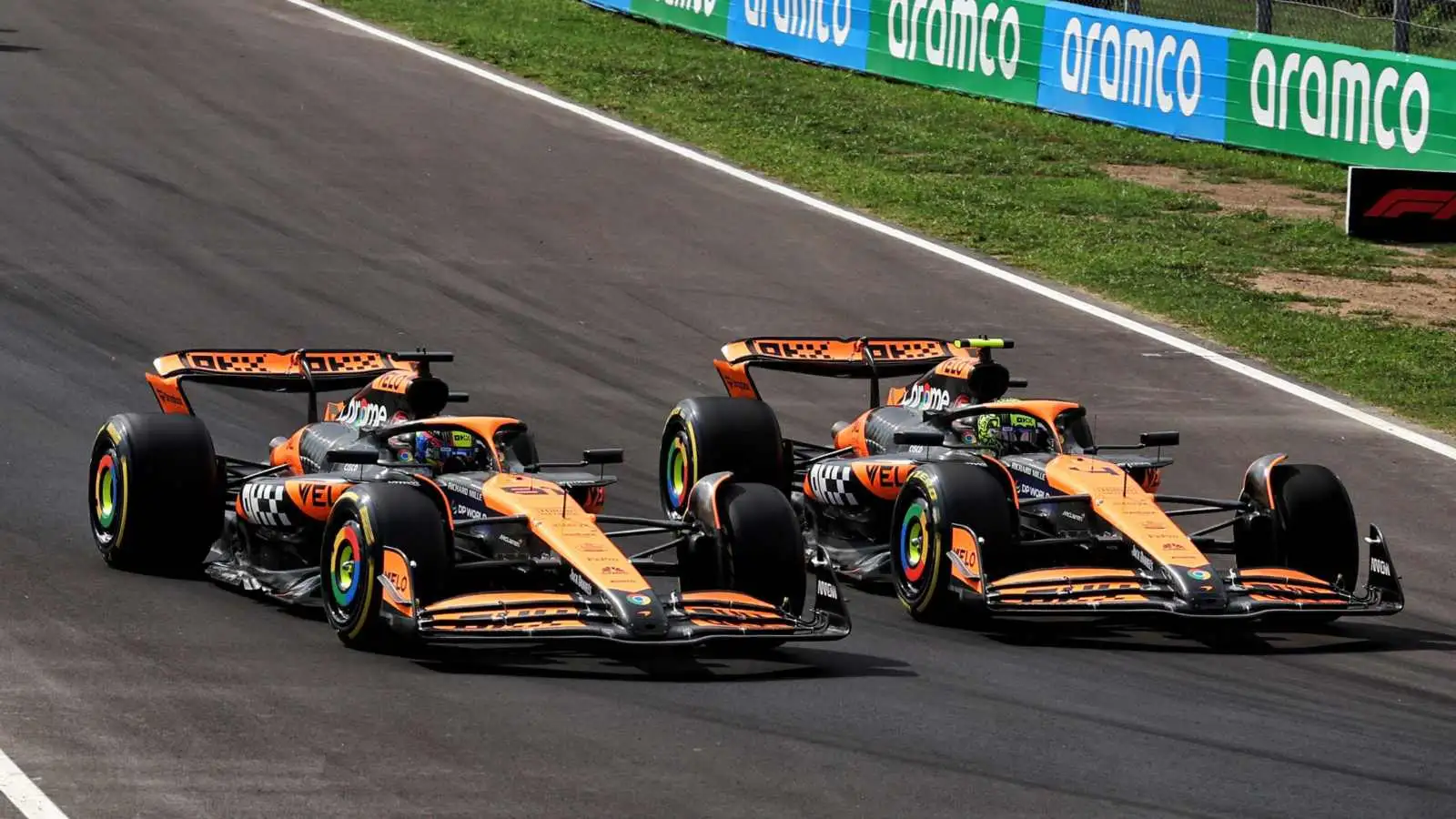
Formula 1 loves a new phrase to talk about, and it got one at the Italian Grand Prix when ‘papaya rules’ entered the lexicon through McLaren.
Its first use came about after Lando Norris and Oscar Piastri locked out the front row at Monza, with a stern reminder from team principal Andrea Stella to keep the racing clean between the team’s drivers.
‘Papaya rules’ explained: What does this McLaren term mean?
Additional reporting by Thomas Maher and Sam Cooper
Essentially, ‘papaya rules’ seems to be the newfound McLaren shorthand for “keep your racing clean”, but phrased in a way that’s kept within its corporate guidelines – given ‘papaya’ is the official colour of the Woking-based outfit.
Even before it was heard in the race when Norris’ race engineer, Will Joseph, told him that he was free to race Piastri after falling behind but within ‘papaya rules’, Stella had offered his own explanation of what the term meant after qualifying at Monza.
“Our recommendation is always racing with the papaya rules, whereby, when the car is papaya, like you are always careful with any other competitor, but if the car is papaya, you take even extra care,” he told media including PlanetF1.com.
“We need to make sure, especially being the car so competitive, that we see the chequered flag and that we try and drive the race in synergy between our two drivers, rather than thinking that my main competitor is my team-mate.
“We try to stay away from this kind of mindset, because it’s not productive.”
Norris was asked for his own explanation of what the term means, and he put it rather more succinctly after Piastri overtook him on the first lap of the race, saying the term means: “Just don’t crash. That’s all.
“There was no contact, so [Piastri] did a good job.”
More reaction to ‘papaya rules’ and McLaren’s F1 2024 title challenge
👉 F1 2024: Head-to-head race statistics between team-mates
👉 Italian GP data: How McLaren’s ‘papaya rules’ gifted win to Leclerc and Ferrari
Will ‘papaya rules’ change at McLaren?
Rules of engagement between team-mates – especially those at the front of the field – are far from a new concept in Formula 1, but it is the first time that there has been a public acknowledgement of these rules existing while under a catch-all term that also matches the relevant team’s branding.
And after Piastri’s bold move on his team-mate at Monza, the McLaren team principal confirmed that these rules are not set in stone, and can be adjusted dependent on their situation – especially given their ever-improving circumstances in the F1 2024 title race.
“We will have to review together with the drivers, look at the videos, understand their point of view, and then we will assess together whether they were fully compliant or not,” Stella told media including PlanetF1.com after the Italian Grand Prix regarding Piastri’s overtake and whether or not it complied with ‘papaya rules’.
“We will take the learning, if there is any learning that we need to take, and then we will adjust the ‘papaya rules’ such that they allow us to pursue in the best possible manner both the Constructors’ Championship and the Drivers’ Championship because we have to be now in condition to acknowledge that not only the Constructors’ Championship is possible.”
What other famous examples of F1 rules of engagement have been communicated in the past?
Red Bull had the infamous ‘Multi-21’ saga at the 2013 Malaysian Grand Prix, though because this was an example of team orders at a time when they were banned, and they were looking to disguise them covertly as an engine map setting, we only found out about it because Sebastian Vettel broke the rules in overtaking Mark Webber for the lead of the race.
This led to extremely awkward scenes in the cooldown room afterwards, with ‘Multi-21’ meaning Car 2 [Webber] was meant to stay ahead of Car 1 [Vettel], but the German took matters into his own hands.
In other famous team orders, there was Ferrari’s Felipe Massa being told in no uncertain terms that “Fernando is faster than you” at Hockenheim in 2010, Valtteri Bottas getting the “Valtteri, it’s James” message from now-Williams team principal James Vowles, when he was asked to move aside for Lewis Hamilton at Mercedes, and Rubens Barrichello being told to give up victory at the 2002 Austrian Grand Prix for Michael Schumacher, doing so on the line in one of the most controversial finishes in Formula 1 history.
In McLaren’s own past, among their multiple on-track duels, the relationship between Ayrton Senna and Alain Prost became so tense and so paranoid about preferential treatment between one and the other away from the track, that former McLaren co-ordinator Jo Ramírez revealed that the two drivers’ crews would pick engines blind, so as to not know the difference.
He told Mundo Deportivo in Spain: “Ayrton always had a fear. He would tell me: ‘Alain will always have the best car because he has been with McLaren the longest, he will always have the best engine because the connection between him and Honda is so strong’.
“And it got to the point that when we received the engines, we would tell them: ‘These are the five engines we are going to use in this Grand Prix’. And in one race Senna’s chief mechanic would choose his engines and in the other race Prost’s chief mechanic would choose his engines, and the mechanics didn’t even have a clue which one was better.
“There is always a little variation between engines… about five or eight horsepower difference… but there was no more suspicion and controversy. They weren’t going to complain anymore, so they knew there was no favouritism.”
Read next: F1 points all-time rankings: Where do Hamilton, Verstappen and Alonso feature?
